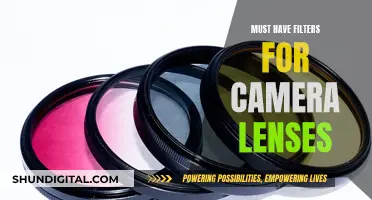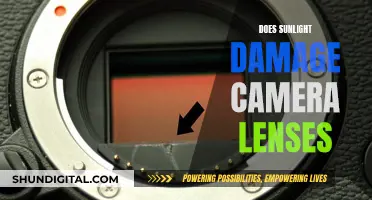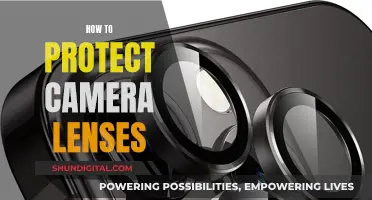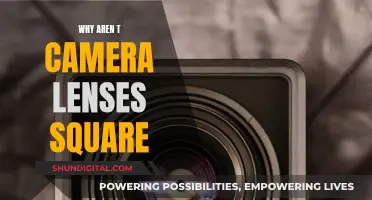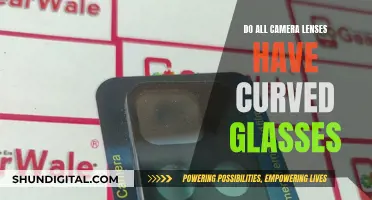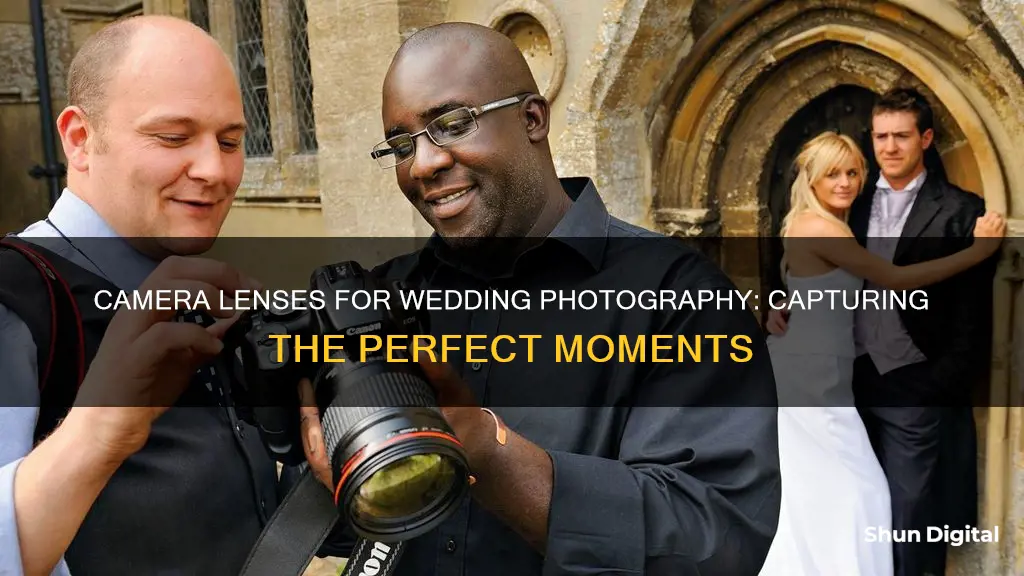
Wedding photography requires a range of lenses to capture the day's events, from the bridal portraits to the exchange of rings and the first dance.
- 70-200mm f/2.8 telephoto zoom lens: Perfect for portraits, creative background blur, and capturing candid moments without disrupting the action.
- 24-70mm f/2.8 standard zoom lens: Versatile and always ready, this lens is wide enough for most interiors and can also be used for impromptu portraits.
- 16-35mm f/2.8 wide-angle lens: Great for shooting in churches, reception venues, and group shots, especially in confined spaces.
- 90-100mm macro lens: Ideal for close-ups of rings, table decorations, and portraits, with a flattering focal length and the ability to capture tiny details.
- 35mm f/1.4 or 1.8 prime lens: Perfect for candid shots with a wide aperture to handle low light and deliver a nice background blur.
What You'll Learn
- mm f/2.8 telephoto lens: perfect for portraits and creative background blur
- mm f/2.8 standard zoom: the ideal ready-for-anything lens to keep on the camera
- mm f/2.8 wide-angle: perfect for the church, reception, and group shots
- mm macro lens: for close-ups of the ring and table decorations
- mm f/1.4 or 1.8: the classic focal length for candid shots, with a wide aperture to handle low light

70-200mm f/2.8 telephoto lens: perfect for portraits and creative background blur
The 70-200mm f/2.8 telephoto lens is a must-have for wedding photography. It is a versatile lens that gives you amazing sharpness at all focal lengths. The bokeh is beautiful, especially at 200mm, and you can achieve a pleasing foreground blur, too.
This lens is perfect for capturing candid expressions and serendipitous moments from a distance, especially during the wedding ceremony when you want to remain discreet. It allows you to capture the exchange of rings, vows, and the kiss without intruding on the moment. With this lens, you can also capture details from a distance, such as the wedding rings, decorations, and the bride's dress.
The 70-200mm focal length is excellent for flattering portraits. It creates amazing separation between the subject and the background, producing a beautiful blur at wide apertures. The sharpness of the images is stunning, especially when paired with a fast shutter speed.
The 70-200mm f/2.8 telephoto lens is also available in a lighter and more compact version with an f/4 aperture. While this option may not offer the same low-light performance or background blur, it is much more cost-effective and easier to carry around during a long wedding shoot.
Understanding Camera Lenses: Break-In Periods and Performance
You may want to see also

24-70mm f/2.8 standard zoom: the ideal ready-for-anything lens to keep on the camera
The 24-70mm f/2.8 standard zoom lens is a versatile lens that is ideal for wedding photography. It offers a wide range of focal lengths, from 24mm to 70mm, making it perfect for capturing both wide location scenes and candid photos of people. This lens is also great for photographing guests arriving, decorations, and details, as well as the first dance and leaving photos.
One of the key advantages of this lens is its constant maximum aperture of f/2.8, which provides exceptional low-light performance and beautiful bokeh. This makes it ideal for capturing candid moments during the wedding ceremony and reception, as well as portrait shots of the bride and groom. The lens also features a ring-type USM and internal focusing mechanism, allowing for quick and quiet autofocus performance.
The optical design of the 24-70mm f/2.8 lens is truly remarkable. It includes one Super UD element, two UD elements, and three aspherical elements, resulting in high-quality images with minimal aberrations and colour fringing. Additionally, a Super Spectra coating has been applied to control flare and ghosting, ensuring high contrast and colour accuracy.
The lens is built to last, with a weather-sealed construction that makes it suitable for use in various environmental conditions. It also features a zoom lock lever to secure the lens at the wide end, making it easy to transport and protecting it when not in use. Overall, the 24-70mm f/2.8 standard zoom lens is an excellent choice for wedding photographers, offering versatility, performance, and high-quality optics.
Are Your Camera Lenses Radioactive? Here's How to Tell
You may want to see also

16-35mm f/2.8 wide-angle: perfect for the church, reception, and group shots
A 16-35mm f/2.8 wide-angle lens is a must-have for wedding photographers. This lens is perfect for capturing the church, reception, and group shots. With its wide-angle perspective, you can fit everyone and everything into the frame, ensuring that no detail is missed.
One of the biggest advantages of using a 16-35mm f/2.8 wide-angle lens for wedding photography is its versatility. This lens allows you to capture a variety of scenes, from the grand church interior to the lively reception party. You can easily switch between different types of shots without having to change lenses. It's especially useful when you need to move quickly and don't have time to swap lenses.
The wide aperture of f/2.8 is another key feature. It lets in a lot of light, making it perfect for low-light situations like indoor ceremonies or evening receptions. You can capture clear and sharp images without having to use a flash, which can be disruptive. The large aperture also creates a beautiful bokeh effect, blurring the background and adding a dreamy, romantic feel to your photos.
Additionally, the 16-35mm focal length range gives you the flexibility to capture both wide-angle shots of the entire venue and tighter shots of groups or individuals. You can showcase the beauty of the wedding location and also capture intimate moments between the couple and their guests.
The 16-35mm f/2.8 wide-angle lens is available for various camera brands, including Sony, Canon, and Nikon. It is known for its high image quality, offering sharp and clear photos with minimal distortion. This lens is also praised for its compact size and lightweight design, making it easy to carry around during long wedding shoots.
Overall, the 16-35mm f/2.8 wide-angle lens is an essential tool for wedding photographers. It enables you to capture the big picture and the small moments, all with stunning image quality and creative flexibility. With its versatility and exceptional performance, this lens will help you tell the complete story of the wedding day.
Microscopic Dust: A Camera Lens Issue?
You may want to see also

90-100mm macro lens: for close-ups of the ring and table decorations
A 90-100mm macro lens is a must-have for any wedding photographer. It is perfect for capturing close-ups of the wedding ring and other small details, such as table decorations, jewellery, and beading on the dress.
The macro lens is a favourite among wedding photographers for its ability to capture detailed shots that make your wedding images look like they belong in a wedding magazine. It is also great for portraits, with its ability to produce beautiful bokeh and sharp images.
The Canon 100mm f/2.8 Macro USM AF Lens is a popular choice, known for producing beautiful, sharp images and its versatility for non-macro pictures. The Tamron AF 90mm f/2.8 Di SP A/M 1:1 Macro Lens is another well-loved lens, praised for its image and build quality, functionality, and value for money.
The Laowa 100mm f/2.8 2X Ultra Macro APO is also worth considering, with its apochromatic design that eliminates chromatic aberration and its ability to focus to infinity, serving as a portrait lens with exceptional optical quality.
With a 90-100mm macro lens, you can capture all the small details that make a wedding so special.
Cleaning Camera Lenses and Filters: A Step-by-Step Guide
You may want to see also

35mm f/1.4 or 1.8: the classic focal length for candid shots, with a wide aperture to handle low light
The 35mm lens is a must-have for wedding photography, especially for capturing candid shots. The 35mm focal length is close to what the human eye naturally sees, allowing you to capture images that give viewers the impression that they were there to witness the scene themselves. This is an important element in wedding photography, particularly in documentary-style wedding photography.
The 35mm f/1.4 or f/1.8 lens is an ultra-versatile lens that can be used to photograph the bride getting ready, including capturing the location, accessories, small details, candid shots, natural interactions, and group portraits, all of which are usually done in a very short amount of time and often in small spaces. The 35mm lens is perfect for these situations as it allows you to get close, which is very handy when you are in a crowded space.
The 35mm lens is also ideal for photographing wider scenes as it gives an expansive view without the exaggerated distortions caused by a wider focal length. This makes it perfect for those "bride getting ready" shots that are essential to the wedding photography business.
Additionally, the 35mm f/1.4 lens can open up to f/1.4, which allows you to photograph in extremely low light, which is especially useful when you are pressed for time and space to use off-camera flashes.
The 35mm f/1.4 lens is super-fast and sharp and will help you capture sharp photos without a tripod, even in low light conditions. It is also more accurate with respect to focusing on a subject.
The 35mm lens is a general-purpose lens with excellent optical stabilisation, image quality, and price, making it perfect for wedding photography, especially for beginners looking to improve their skills.
Optical Image Stabilization: Worth the Extra Cost?
You may want to see also
Frequently asked questions
A 24-70mm f/2.8 lens is a versatile option that can capture wide-angle shots of the entire ceremony, as well as close-ups and portraits.
A 35mm f/1.4 or f/1.8 lens is ideal for capturing candid moments with a wide aperture that performs well in low light.
An 85mm prime lens, such as the Canon EF 85mm f/1.8 USM or the Nikon AF-S NIKKOR 85mm f/1.8G, offers excellent sharpness and smooth bokeh for portraits. For close-ups of rings and other small details, a macro lens like the Canon EF 100mm f/2.8 Macro or the Nikon AF-S VR Micro-Nikkor 105mm f/2.8G IF-ED is ideal.
A 70-200mm f/2.8 lens is a popular choice for wedding photographers as it provides a versatile zoom range, beautiful bokeh, and the ability to capture candid moments from a distance.
Yes, depending on your specific needs, you may want to consider other lenses such as a 50mm prime lens, a 16-35mm wide-angle lens, or a 105mm macro lens.


